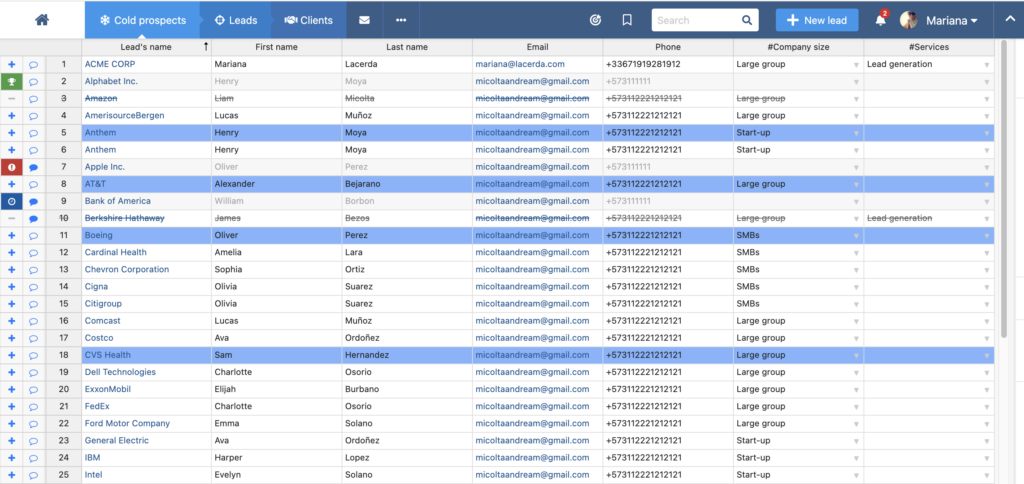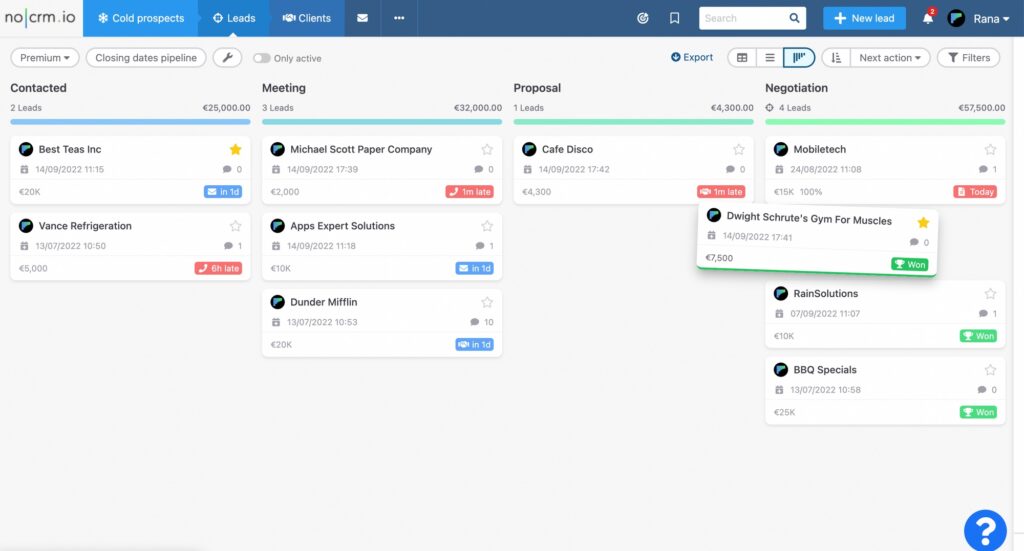
A prospect list is a group consisting of people who may potentially be interested in your product offering or who may benefit from your company and its product or service. Prospects are individuals who have never had contact or very minimal contact with your company.
Building a prospect list is essential for establishing a solid customer base as it provides you with a pool of potential clients who can be treated, nurtured, and followed-up on. Effective prospecting requires planning, organization, and management to ensure each lead potentially turns into a committed customer.
Contents
📌 Key Points
- A prospect list includes people or businesses who match your Ideal Customer Profile (ICP) but haven’t yet engaged with your brand.
- Differentiating between leads and prospects helps optimize your targeting and follow-up strategies.
- Following a clear, five-step process will help you build an accurate, effective list.
- Tools like LinkedIn Sales Navigator, Lead Clipper, and noCRM.io can streamline list creation and management.
Who is a prospect?
A prospect is someone who fits your business’s criteria to become a customer—based on factors like industry, company size, role, and challenges. They have not necessarily interacted with your brand yet, but they could benefit from what you offer.
Prospect vs. Lead
- A lead has shown interest (e.g., filled out a form or downloaded content).
- A prospect fits your target profile but hasn’t yet expressed interest.
For example, if someone named Adam fills out a form on your website, he’s a lead. But until you confirm that he fits your target audience, he’s not a qualified prospect.
What is the purpose of a prospect list & why does your business need one?
Here are four great reasons why a prospect list is useful:
- To reach the right people
- To perfectly position your product/ service
- To be more aware of your prospects
- To provide a list for your Sales or Marketing team to reach out to and sell your product
How to build a prospect list in five easy steps
1. Understand what you’re selling beforehand
Before identifying potential buyers, you need to deeply understand your product or service:
- What problems does it solve?
- What features offer the most value?
- What types of businesses or individuals benefit most?
The better you know your offer, the easier it is to target the right people—and close more deals confidently.
2. Understand your buyer
This may seem obvious, but bear with us! Just like how it is important for you to understand the product/ service, and the role it plays in the market, you must also have a deep understanding of your buyers and the factors that determine them to make a purchase. Especially their challenges and needs, which we will look at in detail below. This vital information will allow you to narrow down your prospect pool even further and make the target audience even more accurate.
3. Create your ideal customer profile (ICP)
To narrow down your prospect pool and target more accurately, sales managers must create their ideal customer profile (ICP)/ buyer persona. Consider ICP as a tool or vehicle to help you better understand your buyer.
To create your ideal customer profile, there are certain search parameters you may need to consider some basic ones like:
- Industry: Identity what industry your best customers come from
- Company size: Do these customers come from a similar company size?
- Job Title: Who are your different profiles involved at different stages in the buying process?
- Revenue: What would be the minimum revenue of the company you want to target?
Once you’ve answers to these basic questions, it makes sense to move forward and refine your search by focusing on deeper issues like:
- Challenges: What problems does your customer face and how can your product solve them? What is the current solution they are using?
- Pain Points: What are the pain points they must be facing, and how does your product relieve these pain points?
After having answers to these questions, you can proceed to the most granular details like:
- Customer lifetime value: how valuable is each of your customers? How much money do they contribute over their lifetime tenure with your company? How does their value correspond with their industry, company size, etc?
- Referral potential: What types of customers have the most referral potential? How much business does your average customer refer?
- Customer loyalty and advocacy: Is there any factors correlated with the probability of a customer becoming a brand advocate?
4. Identify your search portals
Now that you’ve gathered sufficient intel, and you have a good idea of what your ideal customer looks like. It is time to prospect. But, where does the search begin? We recommend these channels to build for the most comprehensive prospect list:
- Go look at your historical or existing prospect data: this should be the first place to get started, the volume of good prospects you may find will be low but it’s still a good start.
- Check in with your partners: partner programs help you go a long way, maintain and nurture these relationships and you may keep getting relevant leads from them.
- Offline events: identify events happening around you where you may have the chance to bump into a prospect. Look out for events, see who it is for, what the theme for an event is and you’ll have a good guess whether to attend the event or not.
- Webinars: organize webinars on relevant topics that address the pain points and challenges of your ideal customers and promote it on social. Follow -up with attendees via email and nurture them.
- Google search: the simplest and most powerful tool, find queries that are most relevant to what you’re looking for, it may not directly lead you to your prospect but will definitely help you to get to know them better.
- LinkedIn: world’s largest professional social network is the best platform you could be using to build your prospect by just doing some basic search on it.
- Purchase a prospecting list: one of the oldest tricks in the book. There are many sources from where you can purchase a prospecting list based upon whom and what you want to target. However, beware that the accuracy of these lists cannot be relied upon and many could be outdated.
5. Import all these lists to your lead management software

Once you have your prospect list, the next step is to import or add the list to your lead management software. This is a very important step because a lead management software will simplify the process of managing these prospects and moving them ahead in the sales pipeline as and when sales reps perform an action on the leads they’ve been assigned. Learn how noCRM.io helps you import your prospect list in the easiest of ways here.
Tools to help you build a prospect list and improve prospecting
Listed below are some tools that’ll help your sales reps in the process of prospecting. They’ll help them build lists, identify ideal customers, and qualify your sales calls.
- Prospectin
Easy to use software for sales reps who want to grow their network, build stronger relationships, making prospecting more reliable and efficient.
- LinkedIn Sales Navigator
For sales managers who want to build a list of ideal customer profiles to target better and more precisely.
- Lead Clipper
Lead Clipper allows you to transform information on a website – and particularly on LinkedIn – into a lead without needing to fill out any details. You can now capture leads on LinkedIn with just a click.
- Sales Script Generator
Sales reps can create scripts for sales reps to use on their calls with prospects. Calls now have a structure, so that no important information is missed and all the data is saved in your noCRM.io account.
You can find more such prospecting tools in our article here.
Tips for Qualifying Prospects
Having a large list of contacts is a great starting point, but not every contact is a promising lead. Use the following criteria to qualify the prospects in your outreach lists:
- Interest/Need: Has the contact shown interest in your product? What are their needs?
- Budget: Does your product fit within the contact’s budget?
- Authority: Does the person have the authority to make purchasing decisions?
- Timing: Is there a clear intention to make a purchase within a specific timeframe?
By qualifying your prospects this way, you can ensure that your efforts are focused on the most promising potential customers.
Optimize prospecting with noCRM.io prospecting lists
Prospecting lists can do wonders but they aren’t of much use if you don’t use them properly. Hence it is imperative that you use prospecting lists along with a lead management software for them to be well integrated.
noCRM.io is a lead management software designed for salespeople by salespeople. We understand all the trouble that goes in at every stage of sales, even while you’re prospecting. With noCRM.io build prospecting lists in a jiffy, follow up with your prospects, and book meetings on the go!


Conclusion
A targeted prospect list is the foundation of sales success. By defining your ICP, researching effectively, and using the right tools, you can build a high-converting list that fuels your pipeline and drives real growth. The process becomes even more powerful when you manage your list using a purpose-built solution like noCRM. Start your 15-day free trial today—no credit card required—and see how fast your prospecting efforts can scale.
FAQ
A prospect is someone who meets your business criteria to become a potential customer.
A lead is a person who has shown interest in your product or services.
Excellent knowledge and comprehension of your product or service will allow you to better target the right profiles to sell your product, ensuring better success at prospecting.
A prospecting list is a collection of potential clients or businesses who match your ideal customer profile. It helps sales teams target qualified leads for outreach and engagement.
To build a high-quality prospecting list, define your target audience, gather leads through research or tools, verify their contact information, and organize them using a CRM or spreadsheet.
A targeted prospect list improves sales success by allowing teams to focus on leads most likely to convert, saving time, personalizing outreach, and increasing ROI.


